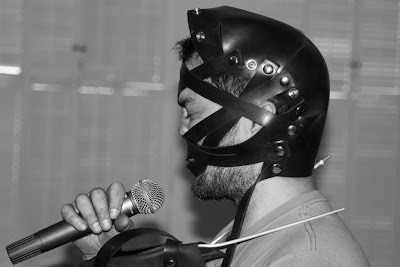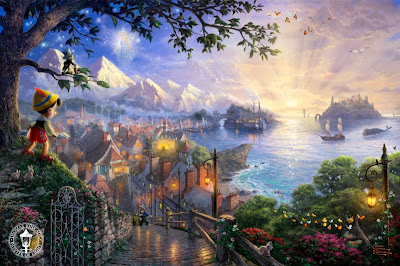Thursday, May 17, 2012
Bouncy Stonehenge
Who doesn't love a bouncy castle?
This art piece has stuck in my mind since I saw a video of it online. Artist Jeremy Deller has fused "bouncy technology" with perhaps the world's original castle: Stonehenge. It's an inflatable version of Stonehenge that you can jump around on! Aside from looking like a lot of fun, it seems like something Spinal Tap would have in the parking lot of their reunion tour. On another note, I think it goes a long way towards demystifying the original structure itself in that it allows visitors to play within the architectural space. Having never visited Stonehenge, I don't know much about what it's like to be in the presence of these stones. I imagine a lot of tourists visiting the original Stonehenge have been conditioned to expect some kind of druid-like transcendence to wash over them as they stand in sight of the giant monoliths... Well, there's a fine line between druid-like transcendence and pretension. Just in case you wondered, the title of the piece is "Sacrilege." This piece reminds us that the coolest thing about Stonehenge is that no one really knows what this monument was used for and that it's a wonderful mystery to consider how the giant stones were actually put together. I don't mean to downplay the solemnity of what is perhaps the UK's most important architectural monument, but let's not forget that "the ancients" probably liked to have fun too. Check out the videos below:
http://www.youtube.com/watch?v=gOSKkLJdjfA
http://www.bbc.co.uk/news/entertainment-arts-17777997
http://www.youtube.com/watch?v=lr7blOccbO4
http://www.youtube.com/watch?feature=endscreen&NR=1&v=beYLiDRvdvQ
http://www.guardian.co.uk/artanddesign/2012/apr/20/jeremy-deller-inflatable-stonehenge-glasgow
Friday, May 11, 2012
Tetsunori Kawana: Bamboo magic in Denver
Sculptor Tetsunori Kawana has just completed an installation at the Denver Botanic Gardens. Ed Montovani was there to act as a special artist assistant (and Free Agent Dilettante correspondent) during the installation. The sculpture is made entirely of bamboo for an exhibit entitled "Kizuna: West Meets East."
Pictured above is Ed Montovani. You can almost hear him saying, "Yeah, I made this. Yeah, it kicks ass."
From what Montovani tells me about Kawana's method, the bamboo is split length-wise, allowing it to bend into the incredible shapes he creates... with help from his assistants, of course.
This is the work of an artist who has clearly mastered his medium. He seems to effortlessly transform stiff bamboo into flowing forms evoking cascading water or whirlwinds. He transforms his medium into something else - certainly something larger than the sum of it's parts, and if art isn't about transformation then I don't know what it's about. Bamboo normally grows straight out of the ground, bristle-like, perpendicular. Here Kawana manipulates and distorts bamboo so that it caresses and dances on the land. I think this artwork talks about natural processes like flow and growth using (appropriately) natural materials. His ephemeral work makes me think he could be a kindred spirits with Andy Goldsworthy.
This sculpture just went on display and will be up until November 4th. If you're in Denver, go check it out.
Kawana's website "Kawana World" is here.
Now enjoy some photos below that Ed Montovani, Free Agent Dilettante correspondent, Denver resident, new car owner, and all-around cool guy, took during the installation process. (all photos on this post are courtesy of Ed Montovani)
Tuesday, May 1, 2012
Tristan Shone, aka "Author and Punisher," is a metal mad scientist.
Tristan Shone creates some incredible machines. With these machines, he makes some incredible sounds as the industrial-drone/doom-metal band Author and Punisher. All of the instruments on which he plays his music are unique and completely invented by him. This makes an Author and Punisher show something to behold because, not only are you enjoying some body-crushing dark metal, you're trying to figure out just what those machines actually do. Although traditional guitars, drums, and keyboards are no less expressive than the machines Tristan Shone makes we are unused to seeing this kind of musical apparatus and are unsure of how they're used. This unfamiliarity with the equipment renders the performance more bodily, evoking some kind of cyborg struggle played out through metal.
You can listen to the music and watch some of Author and Punisher's musical struggle through the sound and video links below. (this music works best when loud):
The cyborg aspect of Author and Punisher's performance has been accentuated by the debut of some voice-modulating masks that Tristan made to be worn by him and others accompanying him. I have not heard any music made by Author and Punisher using these masks, but the man behind the machines, Tristan Shone, describes them like this: "This is the beginning of a series of voice modulating masks that for the most part will not involve any computer effects. Some actuation will be computer controlled, but I really feel there is enough effect in the voice as it is and I would like to be able to perform acoustically with these masks worn by many musicians."
These masks are pretty awesome and will surely be worn in some distopic future hell-scape...
Tristan Shone's work has been featured in many places, including Wired Magazine and Make magazine. See the stories below:
http://www.wired.com/magazine/2011/11/st_obsessed_machines/
http://blog.makezine.com/2011/08/24/build-tristan-shones-headgear-midi-controller/
Here are a couple other good videos of Author and Punisher performing:
(Apologies for the lack of photo credits. I got most of the images from the A+P website and Tristan Shone's facebook. If you are the photographer of any of these images and want credit, please let me know.)
Friday, April 20, 2012
My Review of 'Jan Tichy - Matrix 164' at the Wadsworth Atheneum, Hartford, CT. (A good show, but enough Chick Austin already!)
First, a description of the show: (Please note that the galleries of this show are deliberately dimly lit, so my photos of the exhibit are somewhat dark.)
When you enter the first gallery you are confronted by 5 marble portrait busts on pedestals with their backs to you, facing the wall.
Also in the gallery are two baroque paintings on opposite walls, a modernist chair, a projection of what looks like scaffolding or skylights on one wall, and another clever projection of a Baroque-style parlor in a corner of the room. As I mentioned, the room is dimly lit.
Another, nearly pitch-black gallery contains a small cityscape sculpture made of white paper tubes, displayed atop a TV monitor lying flat on the floor. See the image at the beginning of this review. The scale of this piece makes the viewer feel Godzilla-size in relation to the model city.
The third gallery displays two wall-size black and white videos whose contrast slowly adjusts in and out so that the images go from being discernible to being completely burnt out. One image is of a wasteland, the other of the ocean. In the middle of the gallery, dividing up the space, are several white strings stretched from floor to ceiling. On one wall is a small, close-up picture of a moth clinging to a mirror, and on the wall facing the entrance to the gallery are 5 identical, dark, imposing images of an Egyptian falcon sculpture, the god Horus.
In the first gallery, the marble busts facing the wall gave me a sense that the busts were clearly on display for someone else. The gallery visitor was excluded from the relationship between the busts and their viewers. But did that exclusion give the viewer more information, or less? Was the viewer just physically behind the busts or behind them metaphorically in the sense of being part of a power structure behind them? The paucity of information, visual and otherwise, in the gallery made me think that no one was getting the full picture. I felt whoever could see the front of those busts was unaware of me in the background. It made me feel as if I was in the control room of a TV show, putting these busts on display but unable to see who was viewing them.
I naturally gravitated toward the paintings on the walls and tried to see them, analyze them, and pick out their details. However, in the darkened galley, that seemed to be a futile effort and also seemed to be missing the point; we as viewers weren't meant to look at these as normal paintings. They were there, displaying some kind of vague Baroque splendor for their owner and patron and we had to settle for that.
The projected image of the Baroque-style parlor in the corner of the gallery, along with the sleek modernist chair also on display seem to provide some insight into who Jan Tichy imagines to be in control of the commodity (aka: the information) in this gallery. I got the sense that the person in control is the one who turned the portrait busts toward the wall and for whose benefit the Baroque paintings on the wall are hung. As viewers of this exhibition we are let into this person's world for a moment. In this case Jan Tichy chose that person to be Chick Austin, the legendary curator of the Wadsworth Atheneum from 1927 - 1944. The projected image of the parlor is from Austin's house on Scarborough Street in Hartford, the projected image of skylights on the wall are from the wing of the museum he built during his tenure there, the paintings are two of his acquisitions, and the modernist chair came from his office. Mr. Austin was an innovative, impressive, and charismatic personality and Jan Tichy mines his curatorial career for inspiration in this room.
I said earlier that Matrix 164 was about the denial of information, but a part of this show was about just plain denial... A word about Chick Austin: At the risk of being permanently barred from the Wadsworth Atheneum, I think the Wadsworth, as an institution, is in denial that the Austin era is over. While Mr. Austin was clearly a genius, an advocate for the museum and Hartford, and a visionary who was clearly ahead of his time, let us take a step back and remember that that time ended in 1944. Eugene Gaddis, a curator at the Wadsworth Atheneum, wrote an excellent biography of Chick Austin called "Magician of the Modern". (You should buy it.) Austin is revered at the Wadsworth. When an artist, like Jan Tichy, arrives to do some work for the Matrix series looking for some local context, I think his curatorial caretakers may be all too eager to lead him to Mr. Austin as an example of what Hartford is about. (I know this is not always the case, as when Matrix 160 artist Kim Schoenstadt roamed all over Hartford looking for inspiration and imagery for her show.) What I'm trying to say is that, while Chick Austin was a towering figure, it may be time to move on. Chick Austin's visionary tomorrows, as ahead of their time as they were, are now our yesterdays. As an institution, it may be time for the Wadsworth Atheneum to leave Chick Austin in the past and seek out more relevant, contemporary, and challenging sources of inspiration for the future. I can't imagine institutions in New York holding a torch for so long for a curator who retired in 1944... It is entirely possible I am wrong-headed in this criticism. If you think so, please let me know in the comments below. Moving on...
 The strongest piece in the show is Installation No. 6 (Tubes). This piece is illuminated by white light from the TV screen on which it is displayed and sits alone in a nearly pitch-black gallery. The contrast between the back-lit sculpture and dark gallery created a sense of disorientation and displacement. As my eyes adjusted I realized that other viewers were standing behind me and next to me, further adding to the uncomfortable sense of disorientation. I realized I was being observed while my eyes were adjusting to the light of the gallery. This realization seemed to inform the sculpture, which is about surveillance. The theme of surveillance fits in with the shows overall theme of the denial of information. The sometimes crawling, sometimes frenzied static of the TV screen that supported the cityscape seemed to give the viewers, standing at a distance, privileged information about the imaginary inhabitants of the city below. The scale of the piece added to the sensation that the viewer was hovering over the city, observing. The darkened cityscape sculpture reminded me of distopic scenes from Blade Runner. Again, the sense that the viewer was engaging in an act of surveillance of whatever information emanated from the city, even though it seemed limited to fairly banal digital blips and static, seemed to do a nice job suggesting that this information was worth observing. Indeed, I felt this piece suggested that information is the currency of our time.
The strongest piece in the show is Installation No. 6 (Tubes). This piece is illuminated by white light from the TV screen on which it is displayed and sits alone in a nearly pitch-black gallery. The contrast between the back-lit sculpture and dark gallery created a sense of disorientation and displacement. As my eyes adjusted I realized that other viewers were standing behind me and next to me, further adding to the uncomfortable sense of disorientation. I realized I was being observed while my eyes were adjusting to the light of the gallery. This realization seemed to inform the sculpture, which is about surveillance. The theme of surveillance fits in with the shows overall theme of the denial of information. The sometimes crawling, sometimes frenzied static of the TV screen that supported the cityscape seemed to give the viewers, standing at a distance, privileged information about the imaginary inhabitants of the city below. The scale of the piece added to the sensation that the viewer was hovering over the city, observing. The darkened cityscape sculpture reminded me of distopic scenes from Blade Runner. Again, the sense that the viewer was engaging in an act of surveillance of whatever information emanated from the city, even though it seemed limited to fairly banal digital blips and static, seemed to do a nice job suggesting that this information was worth observing. Indeed, I felt this piece suggested that information is the currency of our time.You can watch a video I took of the sculpture at the link below. It starts out somewhat dark, so fast forward to the 35 second mark to see when the animation on the screen gets brighter:
http://youtu.be/yOrwJwbFfYo
The third room of the show seems to be about confronting borders, which goes along with the show's themes of control and information-as-commodity. The strings that are stretched from floor to ceiling around the gallery serve to deny access to parts of the room. Viewers are somewhat uncomfortably kept to the edges of the gallery. The projected images on the wall reminded me of the wasteland that runs along the Mexican border in San Diego. Interestingly enough, the image depicts the desert in Israel, and the text presented with the show states that this piece "suggests the borders of Israel itself, with the Mediterranean Sea to the west and the Judaea Desert to the east." Although it was not intended by Mr. Tichy, to me this also strongly evokes where the Mexican/US border meets the Pacific Ocean.
Evoking another kind of border, perhaps the border to the afterlife, are the images of the Egyptian god Horus. (Sorry for the dark image).
The picture of the moth clinging to the mirror, face to face with it's own reflection, enforces the idea of a border between one life and another.
This show speaks about the control of information. The logical question then is, who does the controlling? Jan Tichy puts forth former Wadsworth curator Chick Austin as the man who holds the strings. Although we never see an image of Austin himself, we see objects he brought to the museum, a room in his house, and an image of part of the museum he commissioned to be built. This unseen curator, combined with the images of Egyptian gods and ideas of borders dividing worlds (or even dimensions) in the next room, create an element of spirituality in the show. The unseen curator becomes a Grand Unseen Curator or Arbiter who presents or withholds information, determines whether you will be allowed across borders, and watches over you like a Big Brother. This may be a little bit of conceptual riffing on my part, but that's the conclusion I draw from this show. You may draw other, different conclusions, and I think that's the point. Perhaps more than other contemporary artists, Tichy's work invites many different interpretations. See the show, and let me know what you think.
Tuesday, April 17, 2012
"When bankers get together, they talk about art. When artists get together they talk about money." - Oscar Wilde
"When bankers get together, they talk about art. When artists get together they talk about money."
Oscar Wilde
Oscar Wilde
I'm sorry for the lack of blog posts lately, but I've been dealing with filing my taxes. I'll be back at work bringing you the best contemporary art and culture commentary tomorrow. In the meantime, if you're also dealing with tax stress, know that you are not alone! In fact, there are many examples of famous artists and musicians who are in much worse tax trouble than you. Among them are Willy Nelson, Young Buck, and Lil' Kim. Read their stories and feel good that you're not in their shoes!:
"Bewitched" plus "Mad Men" equals "Bell Book and Candle" - At Hartford Stage
Go see "Bell Book and Candle" at Hartford Stage. This is a new production of the play that inspired the TV show "Bewitched" and it's a great show. I'm not a theater critic, but I can say that the set is great, perfectly evoking the 60's (henceforth known as the "Mad Men" decade), the acting is fantastic, and the dialogue is seductive and witty. You won't be disappointed. The show runs through April 29th in Hartford and is a co-production with Long Wharf Theater in New Haven, CT. Here is a review of the show by Frank Rizzo, the theater critic of the Hartford Courant:
http://articles.courant.com/2012-03-15/entertainment/hc-bell-book-candle-review-20120312_1_shepherd-henderson-first-impressions-john-van-druten
And here is another Frank Rizzo article about Kate MacCluggage, the star of the show:
http://articles.courant.com/2012-03-09/entertainment/hc-kate-maccluggage-0311-20120309_1_gillian-holroyd-john-van-druten-book-and-candle
Sunday, April 8, 2012
This image is a detail of "The Crucifixion" by Matthias Grunewald, 1515, (one panel of the Isenheim Alterpiece)
I think it is appropriate for Easter to post a link to this very interesting article in Wired Magazine about Jerusalem Syndrome, a psychological disorder that is triggered by a visit to Jerusalem. People who succumb to Jerusalem Syndrome experience intense religious feelings and, as detailed in the Wired article, sometimes start to believe they are the second coming of Jesus Christ. Imagine the postcards they send home! Check out the article here:
http://www.wired.com/magazine/2012/02/ff_jerusalemsyndrome/all/1
I think it is appropriate for Easter to post a link to this very interesting article in Wired Magazine about Jerusalem Syndrome, a psychological disorder that is triggered by a visit to Jerusalem. People who succumb to Jerusalem Syndrome experience intense religious feelings and, as detailed in the Wired article, sometimes start to believe they are the second coming of Jesus Christ. Imagine the postcards they send home! Check out the article here:
http://www.wired.com/magazine/2012/02/ff_jerusalemsyndrome/all/1
Saturday, April 7, 2012
The Dark Side of Thomas Kinkade
For now, check out this article from the LA Times... Thomas Kinkade's life was different than his paintings:
http://latimesblogs.latimes.com/lanow/2012/04/kinkade-life-often-at-odds-with-his-pastoral-vision.html
Wednesday, April 4, 2012
Robots are coming to get us
Yes, robots are coming to get us, and Timo Arnall can show you what they'll be seeing right before we hear PEW PEW PEW and they vaporize us with lasers. Check out his awesome video below, which is a compilation of different types of machine-vision.
http://vimeo.com/36239715
You can learn more about Timo and his work here:
http://www.elasticspace.com/2012/02/robot-readable-world
Tuesday, April 3, 2012
Damien Hirst video, retrospective info, official website
Hey Everyone, I posted a link yesterday to a UK Channel 4 documentary about Damien Hirst's retrospective at the Tate Modern that, as it turns out, doesn't work in this country. Fear not, Hirst fans. I've found a YouTube link to the same documentary which does work and I think it's really worth a watch, especially if you want to know how the shark in the tank came about.
As discussed in the video, some people think he's a genius, others think you're a fool to buy some of his work.
Is Hirst even worth discussing as a contemporary artist anymore or has he ascended to "Art History" at this point? (this would change the discussion of his work, in my opinion) Maybe any new work he produces won't be critiqued, just simply analyzed as it enters his art historical oeuvre. And is there anything he can to do to outdo "For the Love of God"?!
Also of interest is Hirst's new official website which displays a live video feed of his studio. So far all I've been able to see are some assistants working on a painting. It's no surprise to see the assistants at work. What would interest me is trying to quantify how much time the master actually makes an appearance on the live feed. I'd be willing to bet it's less than 5% of the time. Anyone have any thoughts about Damien Hirst?
As discussed in the video, some people think he's a genius, others think you're a fool to buy some of his work.
Is Hirst even worth discussing as a contemporary artist anymore or has he ascended to "Art History" at this point? (this would change the discussion of his work, in my opinion) Maybe any new work he produces won't be critiqued, just simply analyzed as it enters his art historical oeuvre. And is there anything he can to do to outdo "For the Love of God"?!
Also of interest is Hirst's new official website which displays a live video feed of his studio. So far all I've been able to see are some assistants working on a painting. It's no surprise to see the assistants at work. What would interest me is trying to quantify how much time the master actually makes an appearance on the live feed. I'd be willing to bet it's less than 5% of the time. Anyone have any thoughts about Damien Hirst?
Monday, April 2, 2012
The "Trough of Sorrow", my new favorite phrase and how it relates to Tacocopter: http://www.theatlantic.com/business/archive/2012/03/the-marketing-genius-of-tacocopter/255092/
Saturday, March 31, 2012
Friday, March 30, 2012
Stones in Hartford and LA
"Stone Field Sculpture" by Carl Andre, in Hartford, CT, is similar in scale and ambition to Michael Heizer's "Levitated Mass" which is currently being installed at LACMA. Both pieces evoke a contrast between geologic time and human time, and reference the use of stone throughout art history. One big difference between these two pieces so far seems to be their reception by the public. While the gigantic stone used for "Levitated Mass" was transported on a specially-designed metal truss, accompanied by cheering crowds, police escorts, and cooperative LA Dept of Transportation workers who took down traffic lights on it's triumphant journey from a quarry outside LA to the yard outside LACMA, the Carl Andre piece was despised when it was installed in 1977, has kept a low profile since then, and has even recently endured suggestions that it be "improved" with a water feature. That pretty well sums up the different attitudes about art in Hartford and Los Angeles!
Levitated Mass, by Michael Heizer
I'm eager to see this piece Levitated Mass by Michael Heizer at LACMA. I'm interested in the enormity of the boulder in the piece. It's interesting that this boulder will not move from the site unless some catastrophic natural event dislodges it, or if there is a large human effort equal to the one that put it there in the first place. The geologic permanence of the piece resonates with the natural history of the LaBrea Tar Pits, which are right next door.
Subscribe to:
Posts (Atom)

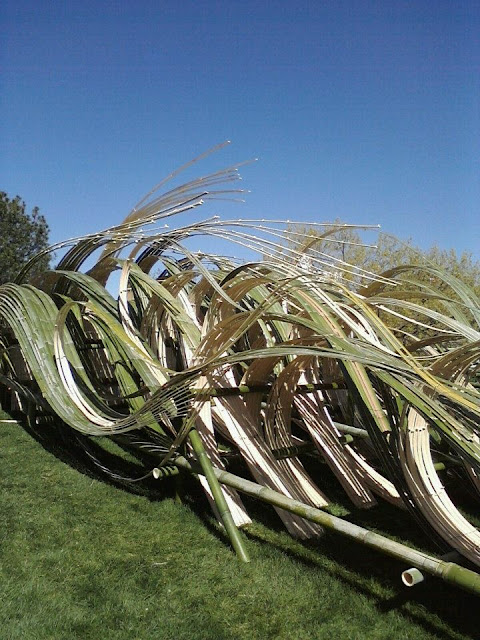
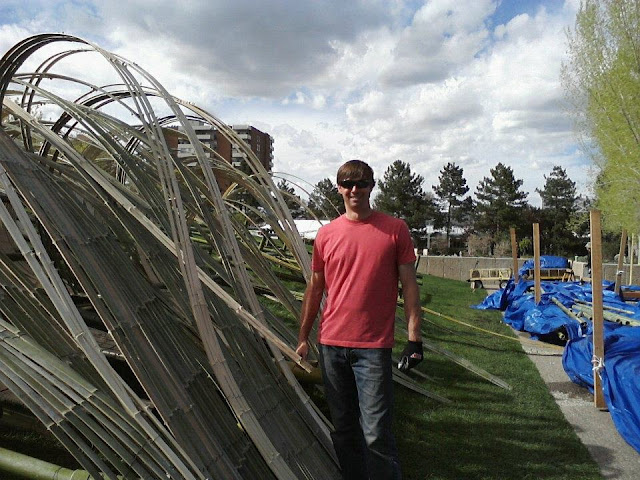
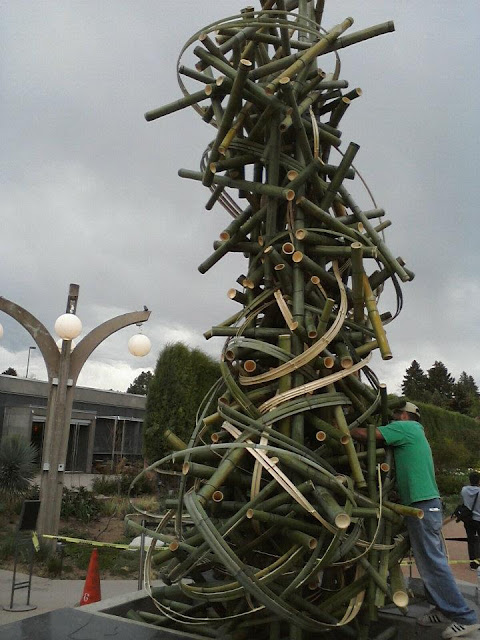
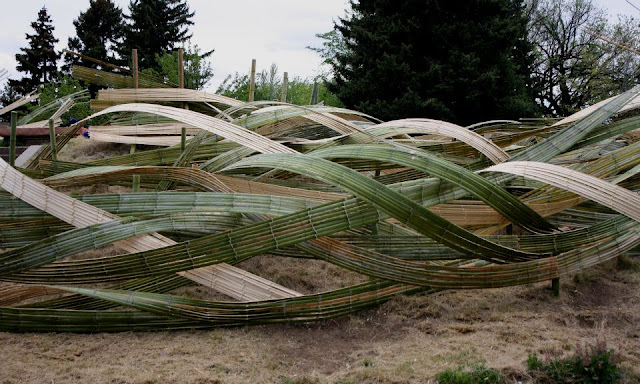



.jpg)



